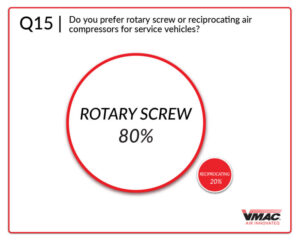VMAC surveyed 340 people in the service truck industry in 2022, asking them questions about their fleets and service truck equipment. The data shows 80% of professionals prefer rotary screw air compressors over reciprocating air compressors on their service vehicles. The 2021 and 2020 survey results also indicated a strong industry preference for rotary screw air compressors.

“Rotary screw air compressors provide continuous airflow and are lighter and smaller than reciprocating air compressors, consistently making these air compressors the industry’s choice for on-board air,” said Gord Duval, VMAC’s vice president of sales and marketing.
When asked why they prefer rotary screw air compressors, 77% of survey respondents noted performance, 41% selected quality and reliability, and 36% said size and weight.
“Rotary screw air compressors deliver more air compared to reciprocating compressors of the same size,” explained Duval. “Mechanics and operators can complete jobs faster and without interruption because rotary screw air compressors operate at 100% duty cycle and do not require a large air receiver tank to keep up with air demand.”
Rotary screw air compressors operate by trapping air between two meshed rotors and reducing the volume of that trapped air as it moves down through the rotors. This reduction in volume results in compressed air, which mechanics and operators use for powering air tools, inflating tires, and numerous other applications.
Over half of survey respondents also rated the air compressor as the most important piece of equipment on their service truck, with Underhood, gas engine drive, and diesel engine drive air compressors being the most preferred types of air compressor systems.
VMAC’s State Of The Mobile Compressed Air Industry Report is released annually to offer its customers, partners, dealers, and members of the service truck industry another resource to stay up-to-date on industry trends and make informed decisions for growth and success. This free report includes 26 questions with insights and analysis from peers in various industries, including construction, agriculture, transportation, oil and gas, forestry, municipal and utilities infrastructure, and mining. Get the report for free at http://www.vmacair.com/survey. To see hi-res charts of VMAC’s data, click here.
VMAC
vmacair.com
Filed Under: Components Oil Coolers, Compressed Air Technologies, News, Pneumatic Tips